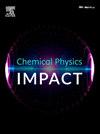新型无铂阳极固态PSII燃料电池的研制及最佳阳极组成的确定
IF 3.8
Q2 CHEMISTRY, PHYSICAL
引用次数: 0
摘要
以光合反应为燃料的固态 PSII 燃料电池有望成为下一代能源设备,但目前,如果没有铂催化剂,这种燃料电池无法产生足够的能量,而且固态 PSII 燃料中质子顺利传输的介质尚不清楚。本研究通过将 PSII 燃料与甲壳素电解质相结合,制造出了一种新型无铂催化剂的固态 PSII 燃料电池。因此,即使没有铂,也能成功获得高功率。在使用每 1 克甲壳素含 8.5 × 10-1 毫克叶绿素 a(Chl-a)的固体燃料时,固态 PSII 燃料电池的功率密度最高。这一结果表明,光合质子生成反应对固态 PSII 燃料电池的发电特性非常重要。此外,研究还发现,磷酸盐缓冲液是 PSII 燃料中质子运输的介质,磷酸盐缓冲液、甲壳素和 Chl-a 在固态 PSII 燃料电池中发电的最佳摩尔比为 1 摩尔:2 摩尔:0.5 毫摩尔。本文章由计算机程序翻译,如有差异,请以英文原文为准。

Creation of novel solid-state PSII fuel cells without platinum anodes and determination of optimal anode composition
Solid-state PSII fuel cells fueled by photosynthetic reactions have the potential to be next-generation energy devices, but currently, they cannot generate sufficient power without a platinum catalyst, and the mediators for smooth proton transport in solid-state PSII fuels are not yet clear. In this study, a novel solid-state PSII fuel cell without a platinum catalyst was fabricated by combining PSII fuel and chitin electrolyte. As a result, high power was successfully obtained even without platinum. The solid-state PSII fuel cell was found to achieve the highest power density when using solid fuel with 8.5 10–1 mg of chlorophyll a (Chl-a) per 1 g of chitin. This result suggests that photosynthetic proton generation reactions are important for the power generation properties of solid-state PSII fuel cells. Furthermore, it was also found that phosphate buffer acts as a mediator of proton transport in PSII fuels and that the optimal molar ratio of phosphate buffer, chitin, and Chl-a for power generation in solid-state PSII fuel cells is 1 mol: 2 mol: 0.5 mmol.
求助全文
通过发布文献求助,成功后即可免费获取论文全文。
去求助
来源期刊

Chemical Physics Impact
Materials Science-Materials Science (miscellaneous)
CiteScore
2.60
自引率
0.00%
发文量
65
审稿时长
46 days
 求助内容:
求助内容: 应助结果提醒方式:
应助结果提醒方式:


